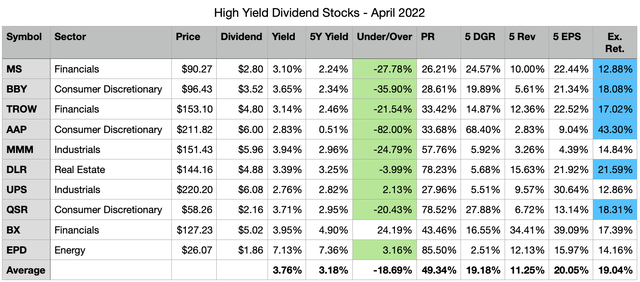Galeanu Mihai/iStock via Getty Images
Market Recap
Stocks finally showed signs of life in March as the S&P 500 picked up 3.76% during the month. Quality dividend stocks started the year on a more positive note; however, March, similar to February, wasn’t a good month for my watchlist. My top 10 high yield dividend stocks for March gained 1.08% during the month. VYM returned 2.76% and SPY gained 3.76%, both performing significantly better than my watchlist. Due to an excellent showing in January, my watchlist is positive on the year with a return of 1.34% and remains ahead of both VYM that is up 0.71% and SPY that is still 4.61% in the red.
The main purpose of a high dividend yield portfolio is not to outperform the broad market but to generate a passive income stream that is safe, reliable, and one that can grow in the future. The top 10 stocks on my watchlist for April 2022, collectively, offer a 3.76% dividend yield that is more than double the dividend yield of the S&P 500. It is also significantly better than the dividend yield of VYM that hovers around 2.75%. These 10 stocks have also grown their dividends at a historical rate of 19.18% per year during the last five years. Collectively, all 10 stocks appear to be potentially about 19% undervalued right now based on dividend yield theory.
The best way to create a strong high yield dividend portfolio is with a buy-and-hold strategy. This strategy forces you to think about the stocks you decide to invest your capital into as the plan is to hold the positions indefinitely. Applying this approach over the long term while focusing on potentially undervalued stocks, allows investors to generate alpha through capital appreciation. While this may not pan out for every position, diversifying your high-yield portfolio across 20 or more unique stocks will increase the odds of picking up shares of certain stocks when they are trading for bargain prices. The beauty of a long-term outlook is time; you can sit back and wait for the valuation to revert to historical norms, all the while collecting a generous passive income stream.
Watchlist Criteria
Creating the high yield watchlist, I had four areas of interest that I focused on: basic criteria, safety, quality, and stability. First off, the basic criterion aims to narrow down the list of stocks to those that pay a dividend, offer a yield above 2.75%, and trade on the NYSE and NASDAQ. The next set of criteria focuses on safety because that is a crucial part of a high yield investing strategy. The filter excludes companies with payout ratios above 100% and companies with negative 5-year dividend growth rates. Another level of safety can be associated with larger companies; therefore, the watchlist narrows in on stocks with a market cap of at least $10 billion. The next set of criteria set out to narrow down the list to include higher quality businesses. The three filters for quality are: a wide or narrow Morningstar moat, a standard or exemplary Morningstar stewardship, and an S&P quality rating of B+ or higher. A Morningstar moat rating represents the company’s sustainable competitive advantage, the main difference between a wide and narrow moat is the duration that Morningstar expects that advantage to last. Companies with a wide moat are expected to maintain their advantage for the next 20 years, whereas companies with a narrow moat are expected to maintain their advantage for the next 10 years. The Morningstar stewardship evaluates the management team of a company with respect to shareholders’ capital. The S&P quality rating evaluates a company’s earnings and dividend history. A rating of B+ or higher is associated with above-average businesses. The last set of criteria focuses on the stability of a company’s top-line and bottom-line growth. The filter eliminates companies with negative 5-year revenue or earnings per share growth rate. I believe a company that is growing both their top-line and bottom-line has the ability to provide growth to its investors in the future.
All of the stocks that pass the initial screener criteria are then ranked based on quality and valuation. Further, I sort the stocks in descending order based on their rank and select the top 10 stocks that are forecasted to have at least a 12% annual long-term return.
April 2022 Watchlist
Here is the watchlist for April 2022. There are no new stocks on the watchlist this month but there is some turnover from the prior month. Bank of Montreal (BMO), Cummins (CMI) and U.S. Bank (USB) fall off the watchlist and are replaced by Blackstone (BX), 3M Company (MMM) and Enterprise Products Partners (EPD). Market volatility has driven many dividend yields higher, and as a result, the watchlist has more stocks to choose from. The data shown in the image below is as of 03/31/22.
Created by Author
Please keep in mind that my return forecasts are based on assumptions and should be viewed as such. I am not expecting that these 10 companies will hit the forecasted returns.
Past Performance
The watchlist for March gained 1.08% last month. The 58 high yield dividend stocks that have appeared on this watchlist had an average return of 2.21%, outpacing the March watchlist. The watchlist lost to both VYM and SPY last month but remains ahead of both benchmarks year-to-date. Since inception, November 1st, 2020, the watchlist is beating VYM and SPY. On an annualized basis, the watchlist has a return of 32.54% through month-end March 2022. My personal target annual return is 12%, so, thus far, this watchlist has far exceeded my expectations. However, the latter part of 2020 and the beginning of 2021 were periods of exceptional returns. While I very much enjoy starting off with a significant cushion, I fully expect the annualized rate of return to fall to a more modest level in the long term.
|
Date |
Watchlist |
ALL |
VYM |
SPY |
|
6 month |
9.12% |
9.86% |
10.21% |
5.96% |
|
3 month |
1.34% |
1.89% |
0.71% |
-4.61% |
|
1 month |
1.08% |
2.21% |
2.76% |
3.76% |
|
YTD |
1.34% |
1.89% |
0.71% |
-4.61% |
|
Since Inception |
49.05% |
51.74% |
47.55% |
41.24% |
|
Annualized |
32.54% |
34.23% |
31.60% |
27.60% |
Individual watchlist returns for March 2022 were:
- (DLR) +6.07%
- (TROW) +5.50%
- (QSR) +5.27%
- (BMO) +3.57%
- (AAP) +1.94%
- (UPS) +1.92%
- (CMI) +0.49%
- (MS) -3.68%
- (BBY) -5.08%
- (USB) -5.21%
Top 5 Stocks by total return since joining the watchlist:
- (BMO) +107.70% (17 months)
- (PFG) +98.47% (17 months)
- (GD) +89.50% (17 months)
- (TD) +88.29% (17 months)
- (CVS) +85.97% (17 months)
BMO adds 3.57% in March and remains the best watchlist stock. PFG adds 4.93% in March and closes in on a 100% total return. TD shed 1.57% and losses its grip on 2nd place to PFG. GD adds 2.87% last month and moves up to 3rd place. CVS shed 2.35% but holds onto 5th place.
Top 5 Stocks by Average Monthly return since joining the watchlist:
- (ATO) +7.42% (4 months)
- (DLR) +6.07% (1 month) NEW
- (BMO) +4.39% (17 months)
- (PFG) +4.11% (17 months)
- (GD) +3.83% (17 months) NEW
Long-Term Returns
In the past, I tracked how a buy and hold approach would have worked out utilizing the ideas from this watchlist. I think a more useful measure that I plan on sharing going forward is what long-term rate of return each month’s watchlist is returning to investors. The watchlist was trimmed to just the top 10 best ideas in November of 2021, before all of the qualified dividend stocks were included in the watchlist. Below are the results of each month’s watchlist since November of 2020 along with a comparison of how SPY performed during the same period of time.
|
Watchlist |
Cumulative |
# of Months |
Annualized |
SPY |
|
Nov 20 |
50.01% |
17 |
33.14% |
27.60% |
|
Dec 20 |
33.59% |
16 |
24.26% |
19.90% |
|
Jan 21 |
28.61% |
15 |
22.29% |
17.88% |
|
Feb 21 |
30.95% |
14 |
26.00% |
20.32% |
|
Mar 21 |
26.11% |
13 |
23.88% |
25.10% |
|
Apr 21 |
15.86% |
12 |
15.86% |
15.49% |
|
May 21 |
13.34% |
11 |
14.64% |
10.62% |
|
Jun 21 |
10.39% |
10 |
12.60% |
10.86% |
|
Jul 21 |
11.79% |
9 |
16.02% |
8.86% |
|
Aug 21 |
10.35% |
8 |
15.93% |
6.11% |
|
Sep 21 |
7.91% |
7 |
13.94% |
1.76% |
|
Oct 21 |
11.14% |
6 |
23.52% |
12.28% |
|
Nov 21 |
6.33% |
5 |
15.87% |
-2.36% |
|
Dec 21 |
10.10% |
4 |
33.45% |
-0.57% |
|
Jan 22 |
2.41% |
3 |
10.01% |
-17.20% |
|
Feb 22 |
-3.30% |
2 |
-18.24% |
4.27% |
|
Mar 22 |
1.08% |
1 |
13.74% |
55.73% |
|
Average |
15.69% |
17.47% |
12.74% |
My personal goal is to achieve a 12% long-term annualized rate of return. Thus far all of the watchlists that have at least 12 months of returns are exceeding my 12% annualized return target. And only 2 of the watchlists that have less than 12 months of returns are not on pace to hit a 12% annualized rate of return. 14 out of 17 watchlists are also performing better than SPY at this time. While this isn’t a requirement for me, it is nice to see this strategy holding its own against the broad equity market.
My expectations are to hit a 12% annual rate of return over a long period of time. I’m not too concerned with short-term underperformance and I will wait patiently for more meaningful results in the coming years.


Be the first to comment